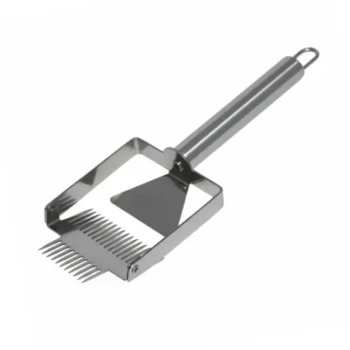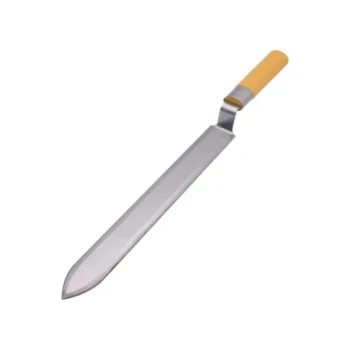For small-scale honey harvesting, you can strain honey effectively using simple materials like nylon bags or food-grade cloth. These are typically placed over a bucket to separate the liquid honey from wax comb and other debris. For larger operations, mechanical straining systems are often used in combination with warming tanks to make the honey flow more easily.
The core task is separating pure honey from wax and debris. The right tool for you depends entirely on your extraction method—either the simple "crush and strain" technique or the more advanced centrifugal extraction.

The Purpose of Straining Honey
Before choosing a tool, it's critical to understand what you're trying to achieve. Straining is the essential step that cleans your raw honey after it has been removed from the comb.
Removing Physical Debris
The primary goal is to filter out any non-honey components. This includes bits of beeswax from cappings or crushed comb, wood splinters from the frames, and any other hive debris.
Creating a Clearer Product
Proper straining results in the clear, beautiful honey that people expect. Unstrained honey can appear cloudy or have solid particles suspended within it, which is less appealing for bottling and selling.
Your Extraction Method Dictates Your Straining Needs
You don't just strain honey in isolation; it's part of a larger extraction process. The method you use to get honey out of the comb will determine how much debris you need to filter.
Method 1: Crush and Strain
This is the most straightforward and low-cost method, ideal for new beekeepers. You simply cut the wax comb out of the frame and into a bucket.
You then use a tool like a potato masher to crush the comb thoroughly. This action breaks open all the wax cells, releasing the honey. Because this method mixes all the wax and honey together, it requires a robust straining process.
Straining Tools for the Crush Method
For this technique, you will need a coarse straining setup. A common approach is to place a nylon straining bag or a sturdy, food-grade cloth over a clean bucket and pour the crushed comb and honey mixture into it. Gravity will do the work, though it can take several hours.
Method 2: Centrifugal Extraction
This method requires more specialized equipment but is much more efficient for larger quantities of honey. It preserves the drawn-out comb so bees can refill it, saving them significant energy.
The Uncapping and Spinning Process
First, a heated or serrated knife is used to slice off only the thin wax cappings from the comb. The frames are then placed inside a honey extractor, which spins them at high speed. Centrifugal force flings the honey out of the cells onto the walls of the extractor, where it drains to the bottom.
Straining After Extraction
While this method produces far less wax debris than crushing, straining is still necessary. The honey will contain fine particles of wax from the uncapping process. A finer mesh nylon strainer is typically sufficient to produce a clean final product.
Understanding the Trade-offs
Each approach comes with its own set of advantages and disadvantages that you must weigh based on your goals and resources.
Cost vs. Efficiency
The crush and strain method is extremely low-cost, requiring little more than buckets and a filter. However, it is labor-intensive and slow, making it impractical for more than a few hives.
Centrifugal extraction is highly efficient and fast, but the initial investment in an extractor and uncapping knife can be significant.
Honey Purity and Pollen
Using a very fine mesh filter will produce exceptionally clear honey. However, this may also filter out some of the naturally occurring pollen, which many consumers value for its potential health benefits. A coarser strain will leave more pollen in the honey.
Making the Right Choice for Your Goal
Your beekeeping journey and scale should guide your decision on equipment.
- If your primary focus is harvesting from your first hive: Start with the crush and strain method using a simple nylon bag or food-grade cloth over a bucket.
- If your primary focus is growing your apiary to several hives: Invest in a centrifugal extractor and a multi-sieve system to save time and preserve your bees' comb.
- If your primary focus is producing "raw" honey: Use a coarse strainer to ensure beneficial pollen remains in the final product.
Ultimately, choosing the right straining tool is about matching your equipment to your extraction process and desired outcome.
Summary Table:
| Extraction Method | Recommended Straining Tool | Best For |
|---|---|---|
| Crush and Strain | Nylon straining bag, food-grade cloth | Small-scale, hobbyist beekeepers |
| Centrifugal Extraction | Multi-sieve system, fine mesh strainer | Commercial apiaries, large-scale operations |
| Raw Honey Production | Coarse strainer | Preserving pollen and natural properties |
Ready to scale your honey production with the right equipment?
HONESTBEE supplies commercial apiaries and beekeeping equipment distributors with high-quality, durable straining systems and extraction equipment through our wholesale-focused operations. Whether you're upgrading to a centrifugal extractor or need bulk straining bags, we provide the reliable tools that help your business thrive.
Contact our expert team today to discuss your specific needs and get a quote tailored to your operation.
Visual Guide

Related Products
- Stainless Steel Pivoting Honey Uncapping Fork with Plastic Handle
- Professional Honey Uncapping Roller for Efficient Harvesting
- All-Stainless Steel Pivoting Honey Uncapping Fork for Beekeeping
- All Stainless Steel Double Sided Pivoting Honey Uncapping Fork
- Adjustable Stainless Steel Honey Uncapping Fork with Scraper for Beekeeping
People Also Ask
- What is the primary use of an uncapping fork in beekeeping? A Guide to Precision Honey Harvesting
- What is the best method for uncapping honey? A Guide to Speed vs. Comb Preservation
- What is the recommended practice when using plain knives for uncapping? Master the Two-Knife Method for a Perfect Harvest
- Why do you uncap honey? Unlock Your Harvest with Efficient Uncapping
- What to use to uncap honey? Choose the Right Tool for Your Apiary



















